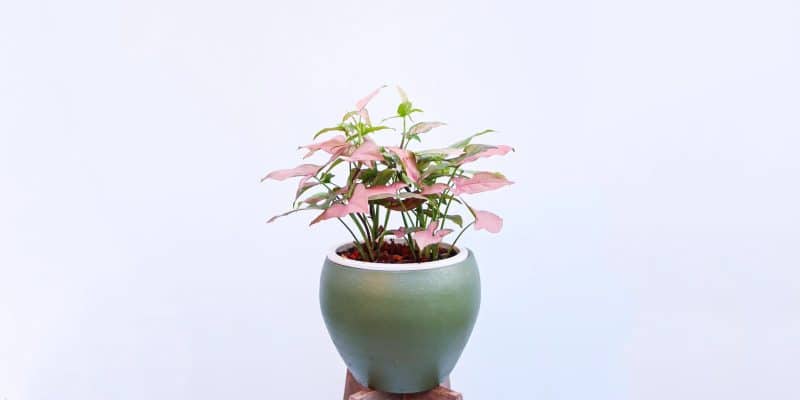Pink Syngonium brings the perfect pop of color to brighten up your living space. It’s got cheerful heart-shaped leaves splashed with vibrant shades of pink. Plus, there are a handful of delightful varieties to choose from!
As we delve into the world of Pink Syngonium care, you’ll learn the essentials for growing your new friend, from watering and sunlight requirements to troubleshooting the most common issues we see.
No plant is perfect, but the Pink Syngonium sure comes close!
Table of Contents
Pink Syngonium Plant Care Guide
History, Habitat, and Characteristics
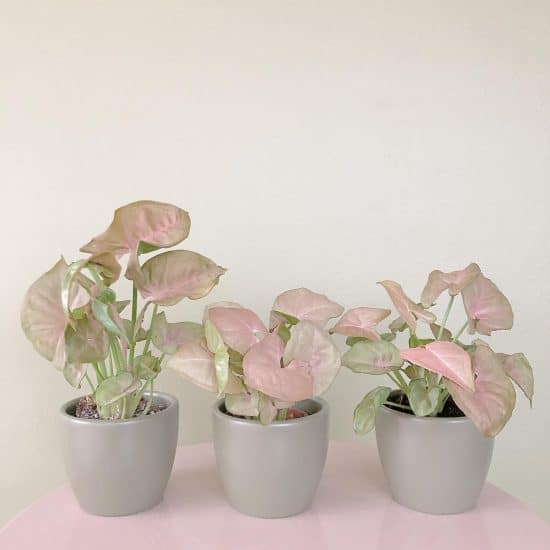
Pink Syngonium (Syngonium podophyllum ‘Pink Splash’) is a breathtaking and well-loved houseplant that hails from the Araceae family. With roots in the tropical rain forests of Southern Mexico, the Caribbean, and Central and South America, these vibrant plants have found their way into the homes and hearts of plant lovers around the globe.
One fascinating feature of syngoniums is their arrowhead-shaped leaves, which have earned them the playful nickname “arrowhead vines,” as well as other variations on “arrowhead.”
In their natural habitat, these plants show off their impressive epiphytic growth, reaching heights of 10 to 20 meters and often climbing neighboring trees for a little extra support. Indoors, you can’t expect it to grow quite that large, but it is a fast grower. It can reach heights as high as 6 feet, so it’ll need a moss pole for support.
Want to think outside the pot? Pink Syngonium can also be planted outdoors in USDA hardiness zones 10 to 12, where it transforms into a gorgeous ground cover that brightens up your landscape.
Varieties
There are several pink syngonium varieties, each with its own unique appearance, but very similar care requirements.
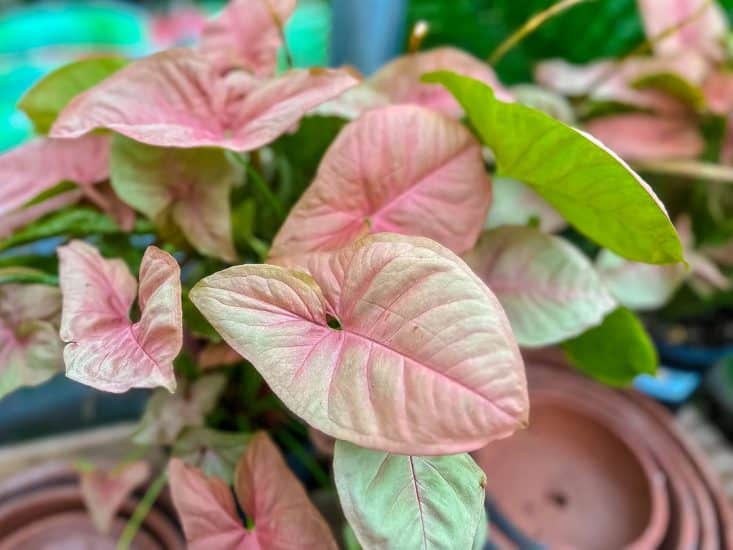
Syngonium Pink Allusion: This variety features soft, pink leaves with pea-green veins.
Syngonium Pink Margarita: A bit more subtle, this variety leads with the green, featuring beautiful rose veins and a mix of green and blush pink leaves.
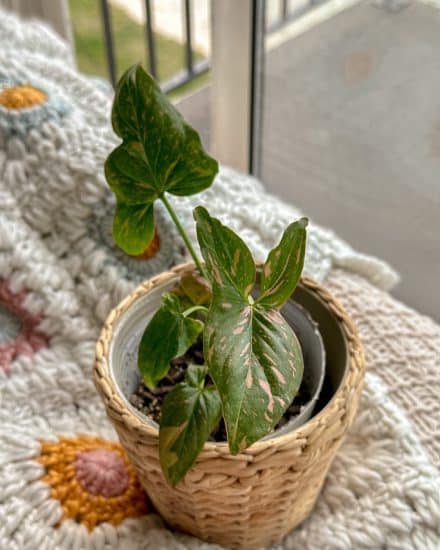
Syngonium Pink Splash: Known for its striking pink speckles and blotches on green leaves, each leaf is uniquely patterned. These tend to require a bit less light, as they contain more chlorophyll in their leaves than more variegated pink varieties.
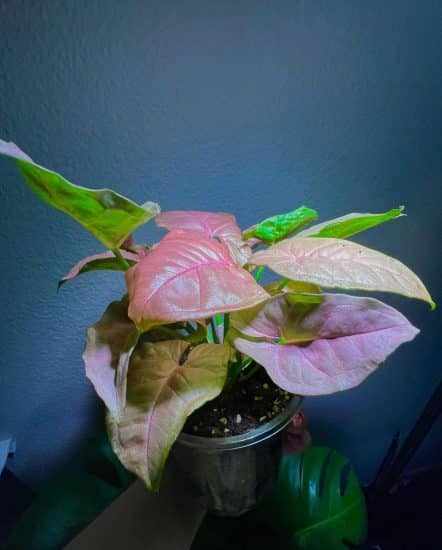
Syngonium Neon Robusta: Also called Syngonium Neon Pink, this cultivar boasts bright pink leaves with occasional green veins, giving it a neon-like appearance. It adds a burst of color and becomes even more vivid with increased light exposure.
Syngonium Berry Allusion: This variety has dark-green leaves with striking pink veins and a more compact growth habit.
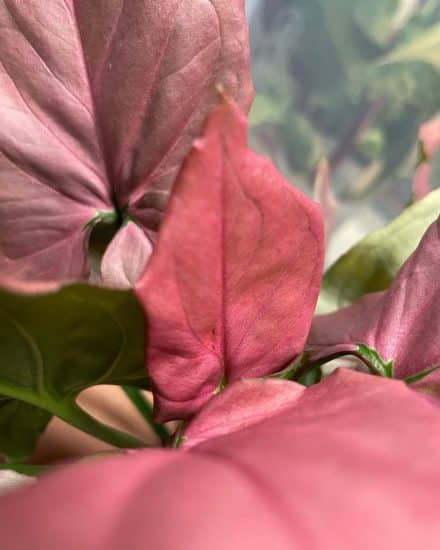
Syngonium Pink Perfection: This variety lives up to its name with stunning, perfectly blended shades of pink on its leaves and just a hint of green. Its leaves showcase a gradient of light to dark pink hues, accented by deep green veins.
Light
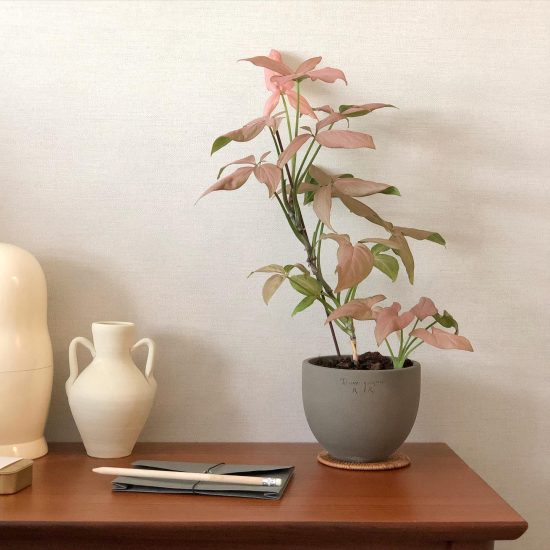
In its native rainforest habitat, Pink Syngonium thrives in bright, indirect light, ensuring that its green foliage, unique coloration, and creamy white variegation are well maintained. You can recreate this exposure by placing your syngonium in an east- or north-facing window.
Placing your Pink Syngonium in a spot with too much direct sun can lead to a few issues that we’d like to help you avoid. You might notice the leaves becoming faded, discolored, or scorched, and the plant might try to protect itself by curling and yellowing its leaves.
To prevent this, simply move your plant to a spot with more filtered or indirect light. A sheer curtain in front of a bright window can help soften the sun’s intensity.
On the other hand, if your Pink Syngonium isn’t getting enough sunlight, it could display slow, leggy growth, and its vibrant pink hues might start turning green. In some cases, the plant’s variegated leaves could even lose their pink splash as it struggles to make the most of limited light.
To address this problem, try moving your tropical plant closer to a south-facing window, or add an artificial light source, such as an LED grow light, to ensure your Pink Syngonium gets the illumination it needs.
Water
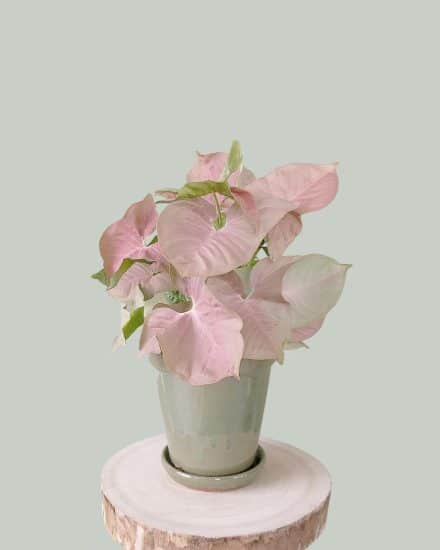
Pink Syngonium doesn’t like to be too wet or too dry, but it will tolerate being a bit dry far more than it will being too wet. Water your Pink Syngonium when the top 1 or 2 inches are dry. Just use your finger to gauge the dryness, or use a moisture meter if you don’t fancy the finger method.
You’ll need to water more during its growth phases in the spring and summer. During these seasons, try to keep the soil evenly moist. Pink Syngonium leaves can turn brown and fall off when overly dry.
To prevent overwatering, make sure the water drains through the pot properly. In winter, let the soil dry out entirely between waterings.
When your Pink Syngonium isn’t receiving enough water, its leaves will start to droop. Drooping leaves can be your plant’s way of telling you it’s thirsty and could use a good drink. Be sure to water it thoroughly when you see this happening, and your plant will perk up in no time.
Too much water can cause yellowing leaves and persistently wet soil. If your plant is overwatered, its roots may struggle to recover. To remedy this, let the soil dry out and cut back on the watering frequency. This will help your Pink Syngonium regain its balance and lead to healthier, more vibrant foliage.
Temperature and Humidity
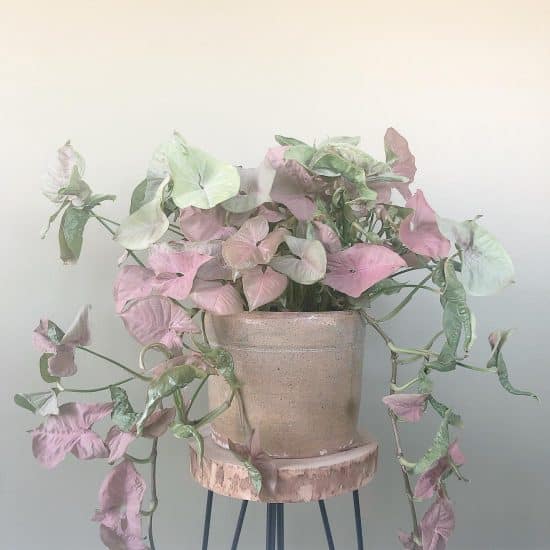
Pink syngoniums enjoy a warm environment, similar to their native tropical habitat. The ideal temperature range lies between 65°F and 80°F (18-27°C).
Be mindful of cold drafts, extreme temperatures, or direct sun, which can cause wilting or drooping leaves. Additionally, avoid placing your Pink Syngonium near heat sources like radiators or air conditioners, which can create temperature imbalances.
When it comes to humidity, Pink Syngoniums can adapt to various levels, but thrive in more humid conditions. Aim for humidity levels between 40%-60% for optimal plant health. Signs of too little humidity include drooping leaves and brown leaf tips, whereas too much humidity can lead to yellowing leaves or potential pest and mold issues.
To raise humidity for your Pink Syngonium, try these tips:
- Place the plant on a pebble tray with water to boost surrounding moisture.
- Run a humidifier close to the plant to raise humidity in the immediate area.
- If feasible, move your syngonium to a more humid room, such as a bathroom or greenhouse.
- Group your indoor plants together, allowing them to share moisture through transpiration.
Keep in mind, misting your Pink Syngonium to raise humidity can potentially cause problems with the leaves (pests, rot). Instead, focus on the tips we mentioned above to create a comfortable environment for your indoor plant to flourish.
Soil and Planting
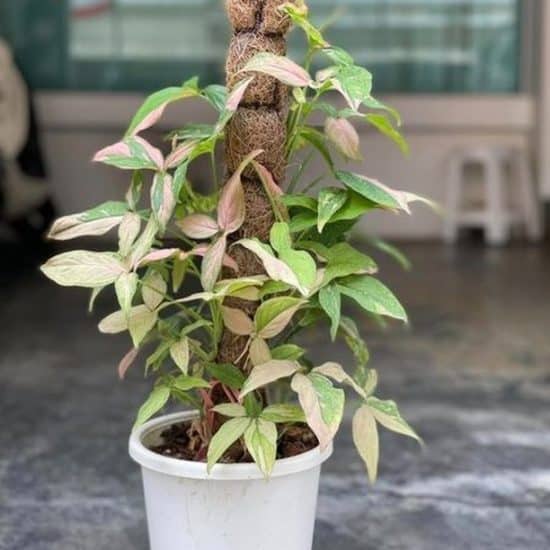
To achieve the perfect potting soil for your Pink Syngonium, use a combination of regular potting soil, cacti soil, and perlite. Pink Syngonium grow best in a well-draining mix, which does a lot for proper growth and root development.
Regular potting soil offers a balanced blend of nutrients and supports your indoor plant’s growth and root development. For improved drainage, incorporate cacti soil, which helps to prevent root rot in syngoniums. Finally, perlite is made of tiny volcanic particles that help to lighten the soil and improve aeration around the roots.
Repotting
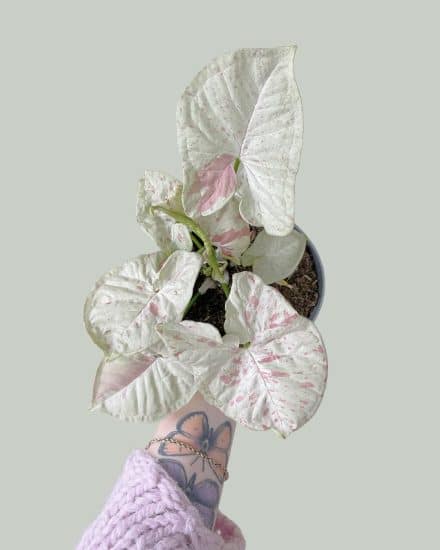
Repotting is an essential aspect of Pink Syngonium care. Plan on repotting your plant every year if its growth is rapid, or every other year if it’s taking its time. To assess whether it’s time to repot, check the root system instead of the size of the leaves. A larger pot may be in order if the roots are becoming cramped.
To provide support for taller syngoniums, add a bamboo pole or stake, and secure your indoor plant to it using garden tape.
For an aesthetic touch, consider adding a layer of orchid bark on top of the potting soil. This acts as mulch and hides the perlite underneath. Additionally, this layer can help with moisture retention, though be mindful that it may also slow down the drying process in some environments. You’ll need to be diligent about checking for dryness before watering.
Fertilizer
During spring and summer, feeding your Syngonium podophyllum will help it maintain its swift growth. For the best Pink Syngonium fertilizer, use a balanced liquid houseplant fertilizer. Be sure to follow the label’s instructions to avoid over-fertilizing. Signs of too much fertilizer include yellow leaves, slow growth, or root damage.
To remedy an over-fertilized plant, adjust your watering schedule and reduce the amount and frequency of fertilization.
Propagation
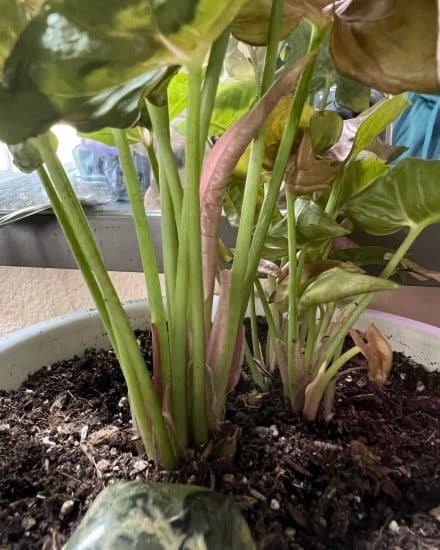
Pink Syngonium propagation is a fun and easy way to multiply your houseplant collection or gift a new plant to a fellow plant lover. We’ll walk you through the stem cutting method, which can be done both in water and directly in soil, to propagate Pink Syngonium.
Keep in mind that propagating during the early spring and summer is your best bet.
Propagating Pink Syngonium via stem cuttings:
- Pick a healthy stem and node: Scout for a healthy stem on your Pink Syngonium with at least one node — that’s the spot where new growth will pop up.
- Snip it off: Grab your sterilized gardening shears and make a cut about half an inch below the chosen node, between two nodes. Aim for at least two healthy leaves on the stem cuttings — they’ll help with growth.
- Prep for the water treatment: Carefully remove any dead leaves from the bottom part of the stem (they’ll rot in water). Fill a small container with filtered water and plop the cutting in. The container should sit in a spot with medium to bright indirect sunlight, but avoid too much light.
- Root watch: Remember to change the water every 2 to 3 days and keep an eye on your little cutting as new roots, such as aerial roots, appear. Once they’re at least two inches long, it’s time for your pink syngonium cutting to move into a more suitable growing medium.
- Or . . . try the soil method: You can also dip the cut end of the stem into some rooting hormone and stick it directly into a well-draining medium, like orchid bark. Be sure to keep the soil moist, but not overly wet, and provide bright, indirect sunlight.
Common Issues
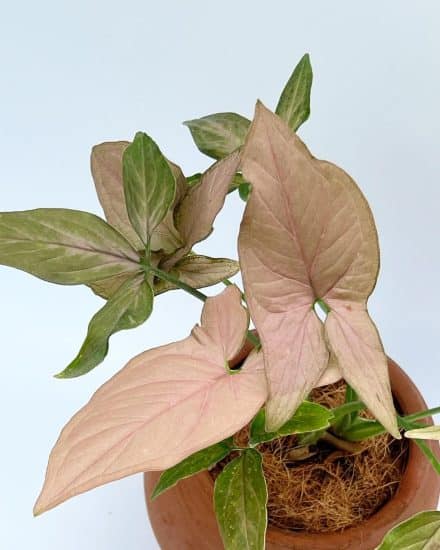
Pink S plants, including varieties like Pink Splash, Strawberry Ice, Pink Spot, and Neon Robusta, are generally low-maintenance, but like any houseplant, they can encounter a few common issues.
Yellow Leaves
When the leaves on your pink syngonium start turning yellow or brown, it’s often a sign of overwatering, which can lead to root rot. To prevent this issue, make sure your plant has adequate drainage by using a pot with drainage holes and allowing the soil to dry out between waterings. If needed, consider repotting your plant with a well-draining soil mix.
Floppy Stems
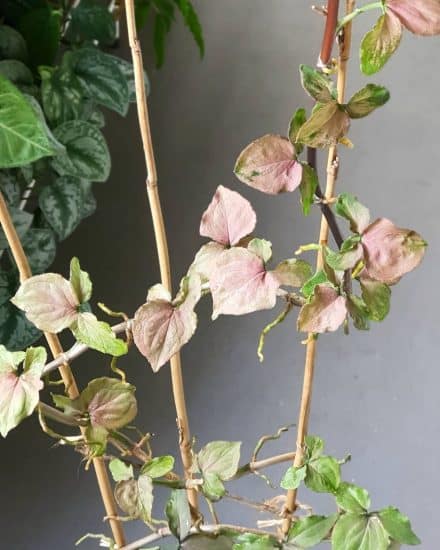
As Pink Syngoniums grow, their stems may become floppy and overgrown, weighing the plant down. To address this, use a moss pole or another type of support in the middle of the plant to securely hold up the stems. As the plant continues to grow, gently tie the stems to the support, encouraging upward growth and maintaining sturdy stems.
Pests and Diseases
Your Pink Syngonium might encounter a few pesky pests or diseases from time to time, but don’t worry, we’ll help you keep your plant healthy and thriving.
Pests
Your Pink Syngonium may sometimes play host to common pests like aphids, spider mites, mealybugs, or scale insects. To spot them, keep an eye out for tiny bugs or webbing on the leaves and stems.
If you do find these critters, first off, isolate the affected plant from your other houseplants so they don’t spread. Gently wipe the leaves and stems with a damp cloth or sponge to remove the pests. For more stubborn infestations, you might need to resort to an insecticide, such as neem oil.
When you’re treating a plant for pests, especially if you’re using any kind of spray on the leaves, the plant is especially sensitive. You may need to give it less water and low light while it’s recovering.
Follow our care guide carefully to ensure a happy and healthy plant — insects tend to invade the unhappy ones. Keep the air circulation flowing and try not to get the leaves wet.
Root Rot
Root rot is a common issue that can sneak up on your Pink Syngonium. This happens when the plant is overwatered or has poor drainage, causing the roots to turn mushy, slimy, and dark. To prevent Pink Syngonium from getting root rot, use well-draining potting soil and a pot with enough drainage. Remember to let the soil dry out a bit between waterings, too.
If you think your Pink Syngonium has root rot, it’s time for action. Carefully remove the plant from its pot and inspect the roots. Using sterilized scissors, cut away any affected roots, and give your plant a fresh start in a new pot. Make sure to evaluate both the soil composition and watering frequency.
Fungus
Fungal problems might be less common, but they can still give your pink arrowhead plant some trouble. Look for telltale signs like small white, circular patches on the leaves, stems, and soil surface. If you spot a fungus, separate your Pink Syngonium from your other houseplants.
Next, remove all affected leaves and stems, and treat your plant with a fungicide according to the product’s instructions. To help prevent future fungus problems, keep your plant in a well-ventilated area with plenty of airflow.
Conclusion
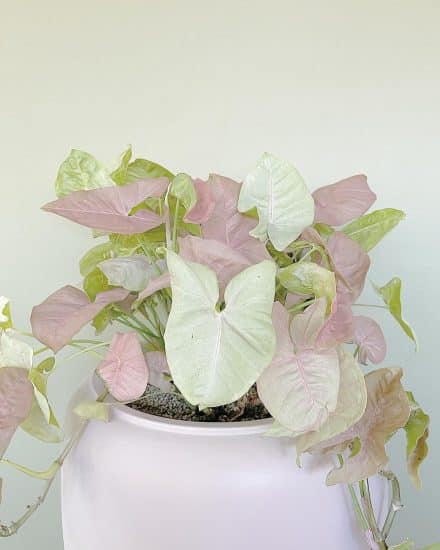
That’s a wrap for our guide on how to care for pink syngonium! Now you have all the necessary knowledge to help your beautiful houseplant flourish and captivate everyone with its stunning pink hues and arrowhead-shaped leaves.
Pink Syngonium care summary:
- Provide bright, indirect sunlight to maintain vibrant leaf colors and avoid direct sunlight to prevent leaf scorching.
- Choose a well-draining potting mix and ensure your pot has proper drainage holes to prevent root rot.
- Water only when the top inch or two of soil is dry, and avoid letting the plant sit in standing water.
- Maintain a warm, humid environment to support healthy growth, with temperatures of 65-80°F (18-27°C) and humidity levels around 40%-60%.
We hope this guide has given you the confidence to welcome a Pink Syngonium into your home and provide the care it needs to thrive.
If you have any questions or concerns, please don’t hesitate to reach out to us. Enjoy your new Pink Syngonium and its rich hues!
FAQ
How do you make your Pink Syngonium more pink?
Achieving that vibrant pink hue in your pink syngonium is all about providing the right conditions for your plant to thrive. Start by ensuring your plant receives adequate light. Too little light can cause the pink color to fade, while direct sun can scorch the delicate leaves.
Next, make sure you’re keeping the plant in its ideal temperature range (65-80°F or 18-27°C) and maintaining proper humidity levels (40%-60%). Optimizing these factors will help your Pink Syngonium maintain its health and vibrant colors.
Finally, regular fertilization during the growing season (spring and summer) with a balanced liquid fertilizer can also contribute to the plant’s overall well-being and help enhance its pink pigmentation.
Is it easy to care for a Syngonium pink arrowhead?
Yes. Caring for a Pink Syngonium is relatively easy, making it a great choice for both seasoned and beginner gardeners. These plants are known for their adaptability and resilience, tolerating various light and humidity conditions.
As long as you provide them with the following essentials, your syngonium should thrive:
- Bright, indirect light, avoiding harsh direct sunlight
- A warm temperature range (65-80°F or 18-27°C)
- Humidity levels between 40%-60%
- A well-draining soil mix to prevent root rot
- Regular watering, allowing the top inch of soil to dry out between waterings
What is the difference between Syngonium Pink Splash and Syngonium Pink Allusion?
Syngonium Pink Splash and Syngonium Pink Allusion differ mainly in their leaf appearance.
The Pink Splash boasts green leaves with highly variable pink speckles and blotches, giving it a unique and unpredictable pattern on each leaf. On the other hand, Syngonium Pink Allusion has soft pink, heart-shaped leaves with lighter pink veins, creating a more subtle, uniform appearance.
Is Pink Syngonium toxic?
Yes, Pink Syngonium is considered toxic to humans and pets by the ASPCA. Pink Syngonium plants contain calcium oxalate crystals, which should not be ingested.
Sources
- https://powo.science.kew.org/taxon/urn:lsid:ipni.org:names:89152-1
- https://www.researchgate.net/publication/321038530_Fifty-five_new_records_of_vascular_plants_and_other_discoveries_for_the_flora_of_Santa_Catarina_southern_Brazil
- https://www.aspca.org/pet-care/animal-poison-control/toxic-and-non-toxic-plants/nephthytis

